2018 Hyundai Kona fuel
[x] Cancel search: fuelPage 470 of 523
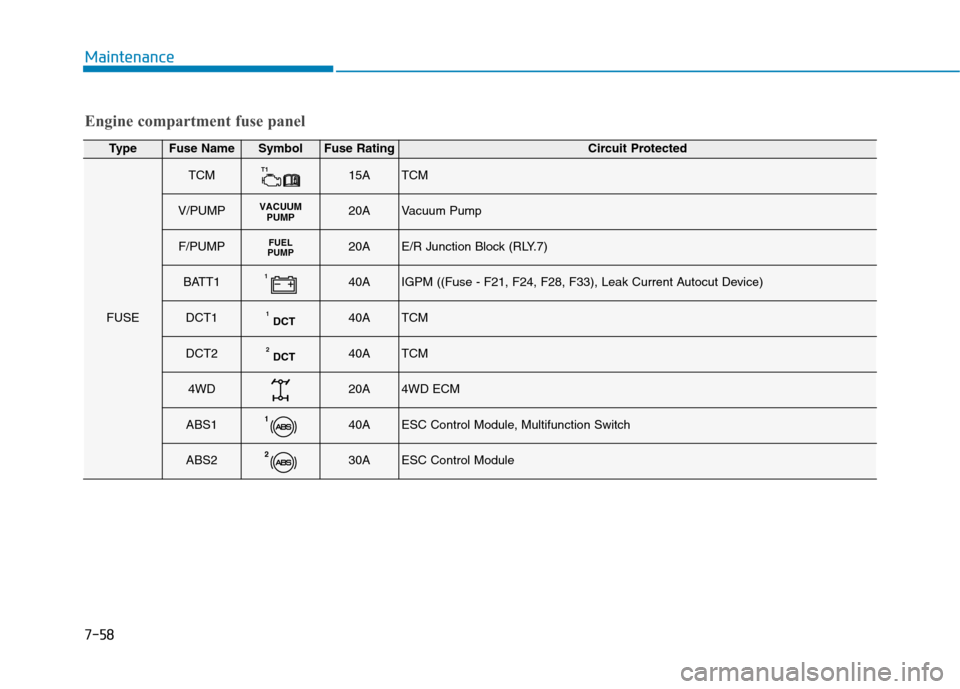
7-58
Maintenance
Engine compartment fuse panel
TypeFuse NameSymbolFuse RatingCircuit Protected
FUSE
TCMT115ATCM
V/PUMPVACUUMPUMP20AVacuum Pump
F/PUMPFUEL
PUMP20AE/R Junction Block (RLY.7)
BATT1140AIGPM ((Fuse - F21, F24, F28, F33), Leak Current Autocut Device)
DCT1DCT
140ATCM
DCT2DCT
240ATCM
4WD20A4WD ECM
ABS1140AESC Control Module, Multifunction Switch
ABS2230AESC Control Module
Page 492 of 523
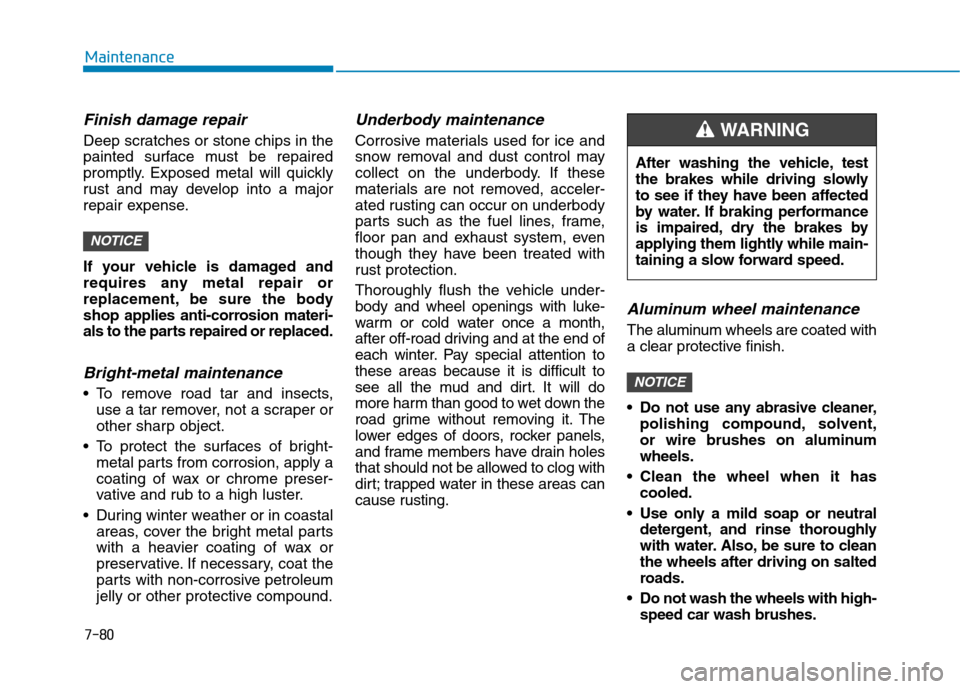
7-80
Maintenance
Finish damage repair
Deep scratches or stone chips in the
painted surface must be repaired
promptly. Exposed metal will quickly
rust and may develop into a major
repair expense.
If your vehicle is damaged and
requires any metal repair or
replacement, be sure the body
shop applies anti-corrosion materi-
als to the parts repaired or replaced.
Bright-metal maintenance
To remove road tar and insects,use a tar remover, not a scraper or
other sharp object.
To protect the surfaces of bright- metal parts from corrosion, apply a
coating of wax or chrome preser-
vative and rub to a high luster.
During winter weather or in coastal areas, cover the bright metal parts
with a heavier coating of wax or
preservative. If necessary, coat the
parts with non-corrosive petroleum
jelly or other protective compound.
Underbody maintenance
Corrosive materials used for ice and
snow removal and dust control may
collect on the underbody. If these
materials are not removed, acceler-
ated rusting can occur on underbody
parts such as the fuel lines, frame,
floor pan and exhaust system, even
though they have been treated with
rust protection.
Thoroughly flush the vehicle under-
body and wheel openings with luke-
warm or cold water once a month,
after off-road driving and at the end of
each winter. Pay special attention tothese areas because it is difficult to
see all the mud and dirt. It will do
more harm than good to wet down the
road grime without removing it. The
lower edges of doors, rocker panels,
and frame members have drain holes
that should not be allowed to clog with
dirt; trapped water in these areas can
cause rusting.
Aluminum wheel maintenance
The aluminum wheels are coated with
a clear protective finish.
Do not use any abrasive cleaner,polishing compound, solvent,
or wire brushes on aluminumwheels.
Clean the wheel when it has cooled.
Use only a mild soap or neutral detergent, and rinse thoroughly
with water. Also, be sure to cleanthe wheels after driving on salted
roads.
Do not wash the wheels with high- speed car wash brushes.
NOTICE
NOTICE
After washing the vehicle, test
the brakes while driving slowly
to see if they have been affected
by water. If braking performance
is impaired, dry the brakes by
applying them lightly while main-
taining a slow forward speed.
WARNING
Page 497 of 523
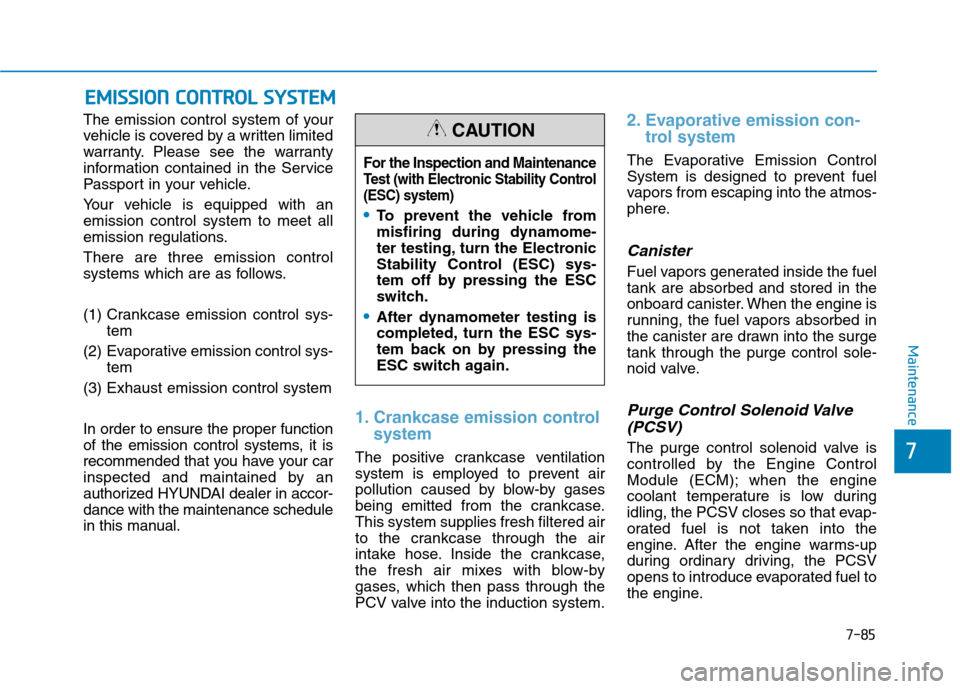
7-85
7
Maintenance
EEMM IISS SSIIOO NN CC OO NNTTRR OO LL SS YY SSTT EEMM
The emission control system of your
vehicle is covered by a written limited
warranty. Please see the warranty
information contained in the Service
Passport in your vehicle.
Your vehicle is equipped with an emission control system to meet all
emission regulations. There are three emission control
systems which are as follows.
(1) Crankcase emission control sys-
tem
(2) Evaporative emission control sys- tem
(3) Exhaust emission control systemIn order to ensure the proper function
of the emission control systems, it is
recommended that you have your car
inspected and maintained by an
authorized HYUNDAI dealer in accor-dance with the maintenance schedule
in this manual.
1. Crankcase emission control system
The positive crankcase ventilation
system is employed to prevent air
pollution caused by blow-by gases
being emitted from the crankcase.This system supplies fresh filtered air
to the crankcase through the air
intake hose. Inside the crankcase,
the fresh air mixes with blow-by
gases, which then pass through the
PCV valve into the induction system.
2. Evaporative emission con-trol system
The Evaporative Emission Control
System is designed to prevent fuel
vapors from escaping into the atmos-
phere.
Canister
Fuel vapors generated inside the fueltank are absorbed and stored in the
onboard canister. When the engine is
running, the fuel vapors absorbed in
the canister are drawn into the surgetank through the purge control sole-
noid valve.
Purge Control Solenoid Valve
(PCSV)
The purge control solenoid valve is
controlled by the Engine Control
Module (ECM); when the engine
coolant temperature is low during
idling, the PCSV closes so that evap-
orated fuel is not taken into the
engine. After the engine warms-up
during ordinary driving, the PCSV
opens to introduce evaporated fuel to
the engine.
For the Inspection and Maintenance
Test (with Electronic Stability Control(ESC) system)
To prevent the vehicle from
misfiring during dynamome-
ter testing, turn the Electronic
Stability Control (ESC) sys-
tem off by pressing the ESC
switch.
After dynamometer testing is
completed, turn the ESC sys-
tem back on by pressing the
ESC switch again.
CAUTION
Page 499 of 523
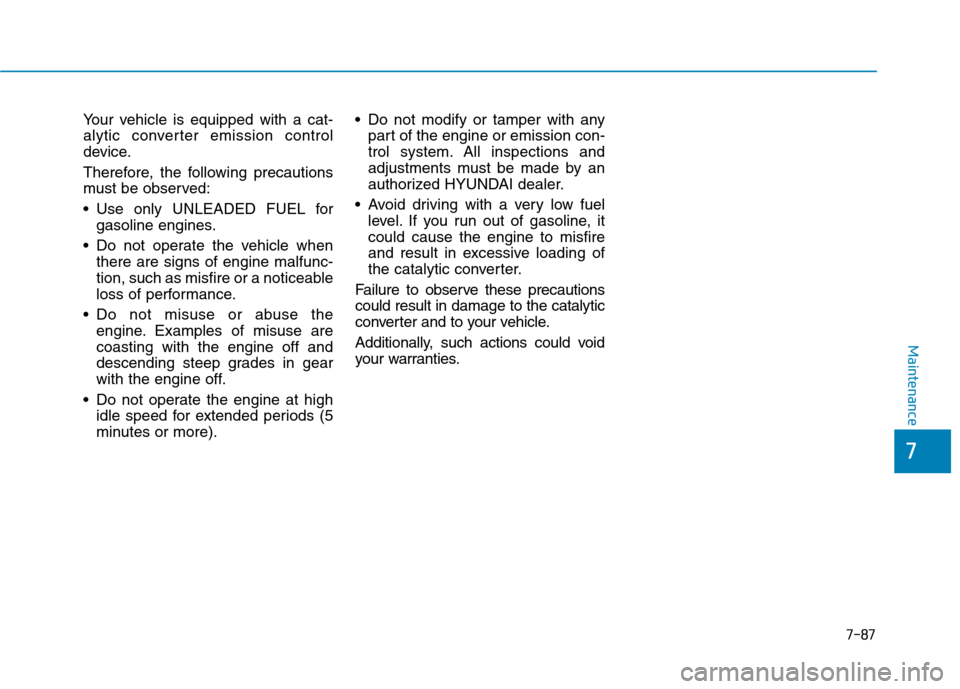
7-87
7
Maintenance
Your vehicle is equipped with a cat-
alytic converter emission control
device.
Therefore, the following precautions
must be observed:
Use only UNLEADED FUEL forgasoline engines.
Do not operate the vehicle when there are signs of engine malfunc-
tion, such as misfire or a noticeable
loss of performance.
Do not misuse or abuse the engine. Examples of misuse arecoasting with the engine off and
descending steep grades in gear
with the engine off.
Do not operate the engine at high idle speed for extended periods (5
minutes or more). Do not modify or tamper with any
part of the engine or emission con-
trol system. All inspections and
adjustments must be made by an
authorized HYUNDAI dealer.
Avoid driving with a very low fuel level. If you run out of gasoline, itcould cause the engine to misfire
and result in excessive loading of
the catalytic converter.
Failure to observe these precautionscould result in damage to the catalytic
converter and to your vehicle.
Additionally, such actions could void
your warranties.
Page 506 of 523
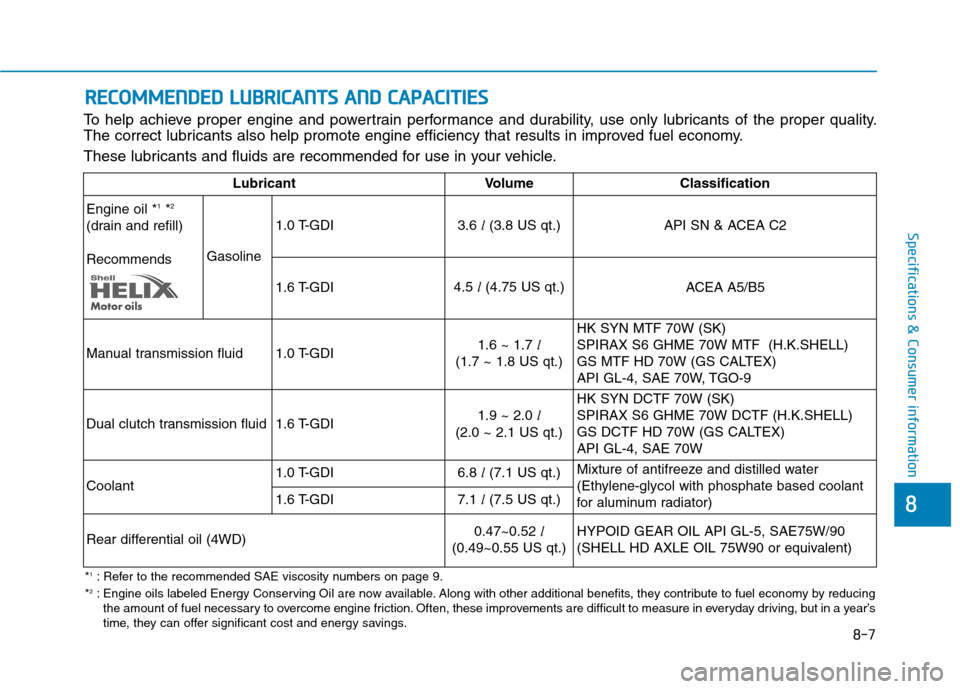
8
Specifications & Consumer information
RREECCOO MM MMEENN DDEEDD LL UU BBRRIICC AA NN TTSS AA NN DD CC AA PPAA CCIITT IIEE SS
To help achieve proper engine and powertrain performance and durability, use only lubricants of the proper quality.
The correct lubricants also help promote engine efficiency that results in improved fuel economy.
These lubricants and fluids are recommended for use in your vehicle.
Lubricant Volume Classification
Engine oil * 1
*2
(drain and refill) Recommends Gasoline1.0 T-GDI
3.6
l(3.8 US qt.)
API SN & ACEA C2
1.6 T-GDI 4.5
l(4.75 US qt.)
ACEA A5/B5
Manual transmission fluid 1.0 T-GDI 1.6 ~ 1.7
l
(1.7 ~ 1.8 US qt.) HK SYN MTF 70W (SK) SPIRAX S6 GHME 70W MTF (H.K.SHELL)
GS MTF HD 70W (GS CALTEX)
API GL-4, SAE 70W, TGO-9
Dual clutch transmission fluid 1.6 T-GDI 1.9 ~ 2.0
l
(2.0 ~ 2.1 US qt.) HK SYN DCTF 70W (SK)SPIRAX S6 GHME 70W DCTF (H.K.SHELL)
GS DCTF HD 70W (GS CALTEX)API GL-4, SAE 70W
Coolant 1.0 T-GDI
6.8
l(7.1 US qt.) Mixture of antifreeze and distilled water
(Ethylene-glycol with phosphate based coolant
for aluminum radiator)
1.6 T-GDI
7.1
l(7.5 US qt.)
Rear differential oil (4WD) 0.47~0.52
l
(0.49~0.55 US qt.) HYPOID GEAR OIL API GL-5, SAE75W/90
(SHELL HD AXLE OIL 75W90 or equivalent)
*
1
: Refer to the recommended SAE viscosity numbers on page 9.
* 2
: Engine oils labeled Energy Conserving Oil are now available. Along with other additional benefits, they contribute to fuel economy by reducing
the amount of fuel necessary to overcome engine friction. Often, these improvements are difficult to measure in everyday driving, but in a year’s
time, they can offer significant cost and energy savings. 8-7
Page 507 of 523
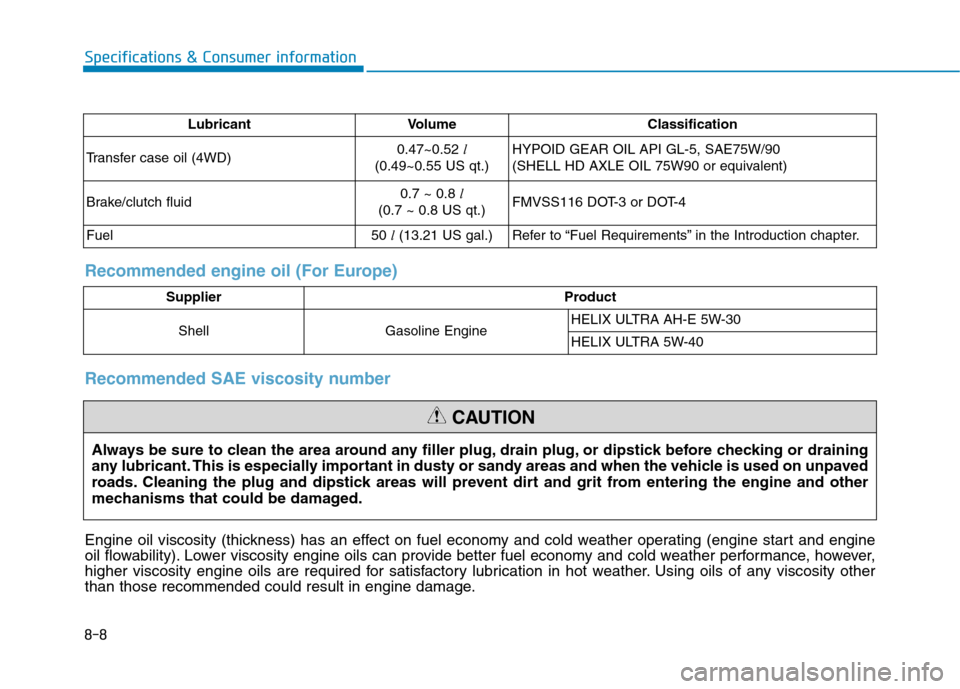
8-8
Specifications & Consumer information
Lubricant Volume Classification
Transfer case oil (4WD) 0.47~0.52
l
(0.49~0.55 US qt.) HYPOID GEAR OIL API GL-5, SAE75W/90
(SHELL HD AXLE OIL 75W90 or equivalent)
Brake/clutch fluid 0.7 ~ 0.8
l
(0.7 ~ 0.8 US qt.) FMVSS116 DOT-3 or DOT-4
Fuel 50
l(13.21 US gal.)
Refer to “Fuel Requirements” in the Introduction chapter.
Recommended engine oil (For Europe)
Supplier Product
Shell Gasoline Engine HELIX ULTRA AH-E 5W-30
HELIX ULTRA 5W-40
Always be sure to clean the area around any filler plug, drain plug, or dipstick before checking or draining
any lubricant. This is especially important in dusty or sandy areas and when the vehicle is used on unpaved
roads. Cleaning the plug and dipstick areas will prevent dirt and grit from entering the engine and other
mechanisms that could be damaged.
CAUTION
Recommended SAE viscosity number
Engine oil viscosity (thickness) has an effect on fuel economy and cold weather operating (engine start and engine
oil flowability). Lower viscosity engine oils can provide better fuel economy and cold weather performance, however,
higher viscosity engine oils are required for satisfactory lubrication in hot weather. Using oils of any viscosity other
than those recommended could result in engine damage.
Page 508 of 523
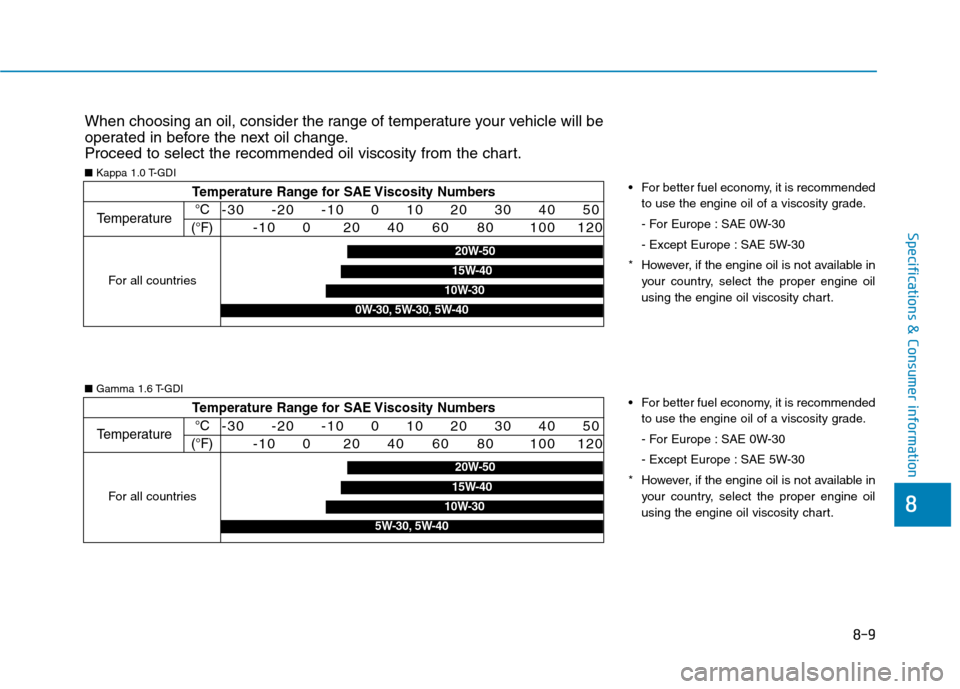
8-9
8
Specifications & Consumer information
When choosing an oil, consider the range of temperature your vehicle will be
operated in before the next oil change.
Proceed to select the recommended oil viscosity from the chart.
Temperature Range for SAE Viscosity Numbers
Temperature°C
(°F)-30 -20 -10 0 10 20 30 40 50 -10 0 20 40 60 80 100 120
For all countries
■
Kappa 1.0 T-GDI
20W-50
10W-30
15W-40
0W-30, 5W-30, 5W-40
For better fuel economy, it is recommended
to use the engine oil of a viscosity grade.
- For Europe : SAE 0W-30
- Except Europe : SAE 5W-30
* However, if the engine oil is not available in your country, select the proper engine oil
using the engine oil viscosity chart.
Temperature Range for SAE Viscosity Numbers
Temperature °C
(°F)-30 -20 -10 0 10 20 30 40 50 -10 0 20 40 60 80 100 120
For all countries
■
Gamma 1.6 T-GDI
20W-50
10W-30
15W-40
5W-30, 5W-40
For better fuel economy, it is recommended
to use the engine oil of a viscosity grade.
- For Europe : SAE 0W-30
- Except Europe : SAE 5W-30
* However, if the engine oil is not available in your country, select the proper engine oil
using the engine oil viscosity chart.
Page 516 of 523

I-5
Engine compartment ...............................................1-8, 7-3
Engine compartment panel fuse replacement...............7-48
Engine coolant ..............................................................7-23
Engine coolant temperature gauge ...............................3-39
Engine number ..............................................................8-11
Engine oil......................................................................7-21
Engine specification .......................................................8-2
Engine start/stop button ..................................................5-9
Evaporative emission control System ..........................7-85
Exhaust emission control system .................................7-86
Explanation of scheduled maintenance items ..............7-19
Exterior care .................................................................7-78
Exterior overview ..........................................................1-2
Front view ..................................................................1-2
Rear view ...................................................................1-3
Floor mat anchor(s) ....................................................3-136
Fluid Brake/clutch fluid.....................................................7-26
Washer fluid .............................................................7-27
Forward Collision-Avoidance Assist (FCA) system ....5-63
Four Wheel Drive (4WD).............................................5-41
Front seat adjustment......................................................2-7 Manual adjustment .....................................................2-7
Power adjustment .......................................................2-9
Seatback pocket........................................................2-11
Adjusting the height up and down ...........................2-16 Forward and rearward adjustment ...........................2-16
Removal/Reinstall ....................................................2-17
Fuel filler door ..............................................................3-34
Fuel gauge.....................................................................3-39
Fuel requirements ...........................................................F-6
Unleaded ....................................................................F-6
Leaded ........................................................................F-7
Gasoline containing alcohol and methanol................F-7
Other fuels..................................................................F-7
Use of MTBE.............................................................F-8
Do not use methanol ..................................................F-8
Fuel Additives ............................................................F-8
Operation in foreign countries ...................................F-8
Fuses .............................................................................7-46 Instrument panel fuse replacement ..........................7-47
Fuse switch...............................................................7-48
Blade type fuse.........................................................7-48
Cartridge type fuse ...................................................7-48
Engine compartment panel fuse replacement ..........7-48
Main fuse..................................................................7-49
Multi fuse .................................................................7-49
Fuse/relay panel description ....................................7-50
Gauges and meters........................................................3-38
Glove box ...................................................................3-128
I
Index
F
G